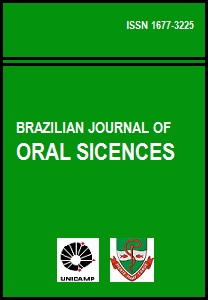Abstract
Aim: To verify whether patients with temporomandibular disorders (TMD) present masticatory muscle hyperactivity with the mandible in the rest position. Method: Forty-six women were selected (18-33 years-old, mean age = 22.7 ± 3.52 years), 31 with TMD (experimental group) and 15 without TMD (control group). Electromyography (EMG) was performed in two situations: 1) with the mandible in the rest position and 2) in maximal dental clenching. RMS (root mean square) was used for EMG signal analysis. Data were analyzed statistically by the Mann Whitney U-test. Result: The experimental groups presented increased EMG activity of the muscles evaluated with the mandible in the rest position compared to the control. In maximal dental clenching, no differences were observed between the groups. Analyzing the percentage of EMG activity at rest, the control group presented EMG activity around 1 to 6% of maximal dental clenching and the experimental group, around 1 to 12% of the same activity. Conclusion: The experimental group presented an increase in EMG activity at rest in the studied muscles, mainly in the anterior portion of the temporal muscle, bilaterally. However, this increase should not be called muscular hyperactivity, but should rather be considered as an important sign of TMD.References
Tvrdy P. Methods of imaging in the diagnosis of temporomandibular joint disorders. Biomed Pap Med Fac Univ Palacky Olomouc Czech Repub. 2007; 151: 133–6.
Yi LC, Guedes ZCF, Vieira MM. Relação da postura corporal com a disfunção da articulação temporomandibular: hiperatividade dos músculos da mastigação. Fisioter Brasil. 2003; 4: 341-7.
Ozan F, Polat S, Kara I, Küçük D, Polat HB. Prevalence study of signs and symptoms of temporomandibular disorders in a Turkish population. J Contemp Dent Pract. 2007; 8: 35-42.
Medlicott MS, Harris SR. A Systematic Review of the Effectiveness of Exercise, Manual Therapy, Electrotherapy, Relaxation Training, and Biofeedback in the Management of Temporomandibular Disorder. Phys Ther. 2006; 86: 955-73.
Pinho JC, Caldas FM, Mora MJ, Santana-Penín U. Electromyographic activity in patients with temporomandibular disorders. J Oral Rehabil. 2000; 27: 985-90.
Faria CRS, Berzin F. Electromyographic study of the temporal, masseter and suprahyoid muscles in the mandibular rest position. J Oral Rehabil. 1998; 25: 776-80.
Bérzin F. Surface electromyography in the diagnosis of syndromes of the cranial-cervical pain. Braz J Oral Sci. 2004; 3: 484-91.
Bérzin F. Estudo eletromiográfico da hiperatividade de músculo mastigatórios, em pacientes portadores de Desordem Craniomandibular (DTM) com dor miofascial. In: Anais do Simpósio Brasileiro e Encontro Internacional sobre dor; 1999. São Paulo. São Paulo: SIMBIDOR; 1999. p. 405.
Liu ZJ, Yamagata K, Kasahara Y, Ito G. Electromyographic examination of jaw muscles in relation to symptoms and occlusion of patients with temporomandibular joint disorders. J Oral Rehabil. 1999; 26: 33-47.
Rodrigues D, Oliveira AS, Bérzin F. Efeito da TENS convencional sobre a dor e a atividade eletromiográfica dos músculos mastigatórios em pacientes com DTM. Braz. Oral Res. 2004; 18: 290-5.
Bodéré C, Téa SH, Giroux-Metges MA, Woda A. Activity of masticatory muscles in subjects with different orofacial pain conditions. Pain. 2005; 116: 33–41.
Lund JP, Widmer CG. An evaluation of the use of surface electromyography in the diagnosis, documentation, and treatment of dental patients. J Craniomandib Dis. 1989; 3: 125-37.
Stohler C, Zhang X, Lund JP. The effect of experimental jaw muscle pain on postural muscle activity. Pain. 1996; 66: 215- 21.
Zarb GA, Carlsson GE, Barry JS, Mohl ND. Disfunções da articulação temporomandibular e dos músculos da mastigação. São Paulo: Santos; 2000. 623p.
Finsterer J. EMG-interference pattern analysis. J Electromyogr Kinesiol. 2001; 11: 231-46.
Mohl ND, Dixon DC. Current status of diagnostic procedures for temporomandibular disorders. J Am Dent Assoc. 1994; 125: 56-64.
Tzakis MG, Kiliaridis S, Carlsson GE. Effect of a fatigue test and chewing training on masticatory muscles. J Oral Rehabil. 1994; 21: 33-45.
Steenks MH, De Wijer A. Disfunção da articulação temporomandibular- do ponto de vista da Fisioterapia e da Odontologia. São Paulo: Santos; 1996. p. 11-193.
Carlson CR, Reid KI, Curran SL, Studts J, Okeson JP, Falace D, et al. Psychological and physiological parameters of masticatory muscle pain. Pain. 1998: 76: 297-307.
Siqueira JT, Teixeira MJ. Dor orofacial: diagnóstico, terapêutica e qualidade de vida. São Paulo: Maio; 2001.
Widmalm SF, Lee Ys, McKay DC. Clinical use of qualitative electromyography in the evaluation of jaw muscle function: a practitioner’s guide. Cranio. 2007; 25: 63-73.
Graven-Nielsen T, Arendt-Nielsen L, Svenssom P. Effects of experimental muscle pain on muscle activity and co-ordination during static and dynamic motor function. Electroencephalogr Clin Neurophysiol. 1997; 105: 156-64.
Graven-Nielsen T, Lund H, Arendt-Nielsen L, Danneskiold B, Bliddal H. Inhibition of maximal voluntary contraction force by experimental muscle pain; a centrally mediated mechanism. Muscle Nerve. 2002; 26: 708-12.
Backman E, Bengtsson A, Bengtsson M, Lennmarken C, Henriksson KG. Skeletal muscle function in primary fibromyalgia: affect of regional sympathetic blockade with guanethidine. Acta Neurol Scand. 1988; 77: 187-91.
Jacobsen S, Eildschiodtz G, Danneskiold B. Isometric and isokinetic muscle strength combined with transcutaneous electrical muscle stimulation in primary fibromyalgia syndrome. J Rheumatol. 1991; 18: 1390-3.
Molin C. Vertical isometric muscle forces of the mandible. A comparative study of subjects with and without manifest mandibular pain dysfunction syndrome. Acta Odontol Scand. 1972; 30: 485-99.
The Brazilian Journal of Oral Sciences uses the Creative Commons license (CC), thus preserving the integrity of the articles in an open access environment.


